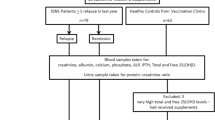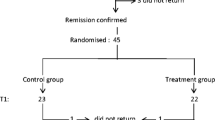Abstract
The effect of prednisone therapy on serum levels of 25-hydroxyvitamin D [25(OH)D] and 24,25-dihydroxyvitamin D [24,25(OH)2D] was investigated in 16 children with nephrotic syndrome. These serum levels were significantly lower in patients before prednisone therapy than in age- and seasonmatched normal subjects. Patients receiving daily prednisone therapy had lower serum levels than those receiving alternateday prednisone therapy at the time when the total amounts of the steroid administered attained 1,500 or 2,000 mg/m2 of body surface area. Daily doses of 40 mg/m2 of prednisone for 3 days caused a significant decrease in serum 25(OH)D levels. Withdrawal of the steroid for 4 consecutive days was followed by a significant recovery of the serum levels.
These results suggest that alternate-day prednisone therapy rather than daily treatment should be used in clinical practice to help maintain normal vitamin D metabolism.
Similar content being viewed by others
Abbreviations
- 25(OH)D:
-
25-hydroxyvitamin D
- 24,25(OH)2D:
-
24,25-dihydroxyvitamin D
References
Barragry JM, Frace MW, Carter ND, Auton JA, Beer M, Boucher BJ, Cohen RD (1977) Vitamin D metabolism in nephrotic syndrome. Lancet II:629–632
Caldas AE, Gray RW, Lemann JL Jr (1978) The simultaneous measurement of vitamin D metabolites in plasma studies in healthy adults and in patients with calcium nephrolithiasis. J Lab Clin Med 91:840–849
Canterbury JM, Lerman S, Claflin AJ, Henry H Norman A, Reiss E (1978) Inhibition of parathyroid hormone secretion by 25-hydroxycholecalciferol and 24,25-dihydroxycholecalciferol in the dog. J Clin Invest 61:1375–1383
Chesney RW, Mazess RB, Hamstra AJ, DeLuca HF, O'Reagan S (1978) Reduction of serum-1,25-dihydroxyvitamin D in children receiving glucocorticoids. Lancet II:1123–1125
Fucik RF, Kukreja SC, Hargis GK, Bowser EN, Henderson WJ, Williams GA (1975) Effect of glucocorticoids on function of the parathyroid glands in man. J Clin Endocrinol Metab 40:152–155
Goldstein DA, Oda Y, Kurokawa K, Massry SG (1977) Blood levels of 25-hydroxyvitamin D in nephrotic syndrome. Ann Intern Med 87:664–667
Hahn TJ, Halstead LR, Haddad JG Jr (1977) Serum 25-hydroxyvitamin D concentrations in patients receiving chronic corticosteroid therapy. J Lab Clin Med 90:399–404
Hahn TJ, Halstead LR, Baran DT (1981) Effects of short term glucocorticoid administration on intestinal calcium absorption and circulating vitamin D metabolite concentrations in man. J Clin Endocrinol Metab 52:111–115
Henry HL, Norman AW (1978) Vitamin D: two dihydroxylated metabolites are required for normal chicken egg hatchability. Science 201:835–837
Jowsey J, Riggs BL (1970) Bone formation in hypercortisonism. Acta Endocrinol 63:21–28
Kanis JA, Cundy T, Bartlet M, Smith R, Heynen G, Warner GT, Russell RG (1978) Is 24,25-dihydroxycholecalciferol a calcium-regulating hormone in man? Br Med J I:1382–1386
Kano K, Yoshida H, Yata J, Abe E, Tanabe R, Suda T (1979) An assay method for separately measuring metabolites of vitamin D3 and those presumed to be derived from vitamin D2. J Nutr Sci Vitaminol 25:351–360
Kano K, Yoshida H, Yata J, Suda T (1980) Age and seasonal variations in the serum levels of 25-hydroxyvitamin D and 24,25-dihydroxyvitamin D in normal humans. Endocrinol Jpn 27: 215–221
Kano K, Nonoda A, Yoneshima H, Suda T (1980) Serum concentrations of 25-hydroxyvitamin D and 24,25-dihydroxyvitamin D in patients with various types of renal disease. Clin Nephrol 14: 274–279
Klein RG, Arnaud SB, Gallagher JC, DeLuca HF, Riggs BL (1977) Intestinal calcium absorption in exogenous hypercortisonism. J Clin Invest 60:253–259
Lukert BP, Adams JS (1976) Calcium and phosphorus homeo-stasis in man. Arch Intern Med 136:1249–1253
Melby JC (1974) Systemic corticosteroid therapy: Pharmacology and endocrinologic considerations. Ann Intern Med 81:505–512
Mitchell I, Barr OGD, Pocock SJ (1978) Catch-up growth in cortisone-treated rats: Effects of calcium and vitamin D. Pediat Res 12:1105–1111
Ornoy A, Goodwin D, Noff D, Edelstein S (1978) 24,25-dihydroxyvitamin D is a metabolite of vitamin D essential for bone formation. Nature 276:517–519
Sturge RA, Beardwell C, Hartog M, Wright D, Ansell BM (1970) Cortisol and growth hormone secretion in relation to linear growth: Patients with Still's disease on different therapeutic regimens. Br Med J III:547–551
Author information
Authors and Affiliations
Rights and permissions
About this article
Cite this article
Kano, K., Suda, T. Serum 25 (OH) D and 24,25 (OH)2 D levels in childhood nephrosis under different therapeutic regimens of steroid administration. Eur J Pediatr 138, 162–165 (1982). https://doi.org/10.1007/BF00441145
Received:
Accepted:
Published:
Issue Date:
DOI: https://doi.org/10.1007/BF00441145




